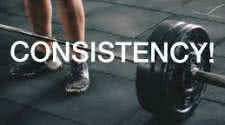Workout Variety vs Consistency: How Often to Change your Workout Plan

Never Stick to the Same Plan.. Variation is Key
Many people in the gym, beginners or professional athletes always make good gains with weight training but then hit a stubborn sticking point. They ask themselves if they need to change their routine that has worked
so well for so many month prior. You may have heard about the advantages of instinctive training, however the question remains is if it's better than a consistent program especially for a beginner?
Instinctive training used to be called the Confusion Principle, whereby you changed your routine every workout. When people ask me about it, my response is always "Just make sure it's not you who's getting confused."
There are only a certain number of exercises that will be effective for you, and you really have to stick with those. It's all right to change them around now and then, but I think it's a mistake to go into the gym
and do something different every workout, because you will have no goals nor a basis against which to gauge each successive workout. For instance, if you can incline press 150 pounds for six reps and come in the next
workout and incline press 150 pounds for eight reps, you can see that you are making measurable progress; but if you do the incline press one workout and don't do it again for the next several workouts, you have no
peak level to try to surpass.
Your problem, I would suspect, is that you have become mentally - not physically - stale. If you're bored with an exercise, the mental stimulus isn't there, so you're not going to put forth the requisite physical
effort to improve your reps or poundage.
What you might do is switch from a barbell to dumbbells for awhile, then return to the barbell later, but I don't believe in changing the core of a successful routine. That should remain pretty much the same.
Legs are a good example. You can do squats, hack squats, leg presses and leg extensions for then that's pretty much it. What else are you going to do, dangle upside down or hang from the roof?
Maybe a professional who has all the mass he needs but wants to perfect some finer details might do something else, such as cable crossovers for upper pecs, but a beginner or intermediate should stick with basic
free-weight exercises and forget about using machines and cables. Such equipment definitely has its uses but only when your musculature becomes more advanced.
Remember, too, maintaining your interest comes from learning how to use free weights. That's another reason I don't recommend my routine for beginners. It took me years to develop the ability and
power I use for my low sets, whereas a beginner is learning not only the movements but also how to produce the intensity. That takes practice, which also means more sets.
We call it "training" for a reason. We're not just building muscle, we're developing the skills involved for getting the most out of the weights. By keeping that in mind, you can also keep your motivation alive.
This is not to say that you need an excessive volume of sets. I recommend two different exercises of three sets each per bodypart, but they must be heavy , free-weight compound movements. It's hard to beat bench presses
and inclines for chest; bent rows and pulldowns for back; squats and hack squats for legs; etc. That's pretty much what I did when I began. When starting out, you don't need a variety of exercises because you're trying
to build a foundation. Later on, if you want to concentrate on smaller details, then you can add other exercises to your regimen.
Be patient, and to keep up your interest, set short-term goals for yourself, such as putting 20 pounds on your bench press in six weeks. Keep in mind, however, that changing your exercises each workout won't give you
much help in attaining that, but persistence and consistency will.